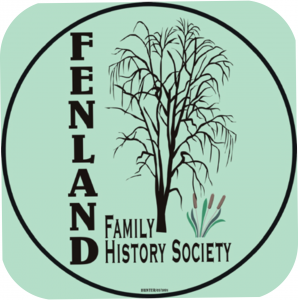Bryan is an experienced local historian and speaker and he used to be a local history tutor in Cambridge. He prefaced his talk by saying that his talk would cover the main elements of the drainage of the fenlands from the 17th century on with a necessarily brief overview of the formation of the area from 7000BC.
Bryan used ancient and modern maps to show how the area around the Wash has gradually been reclaimed from the sea. He was able to show how the vast bay that was originally the Wash as far inland as Wisbech gradually became land as a result of sedimentary deposits from further north. It is known that the area became forested after 7000Bc and in the 4th century BC a great storm felled the forests (all the trees fell in the same direction – even forests in the near continent lie in the same direction) and many of these trees continue to be discovered and are known as “bog oaks”. A recently discovered bog oak at Methwold is currently being planked and turned into a table – the table will be 44 feet long and it is estimated that this is only a quarter of the tree’s original height!
It is known that the climate has had warmer and cooler periods and it is thought that the Roman occupation of Britain occurred at a time when the climate was warmer and drier and was then followed by several centuries of cooler, wetter weather. Drainage and man’s intervention has also altered the level of the land. Drainage has taken place at different times over the centuries with the most sustained efforts taking place in the 17th century. The effects of drainage and its drying out of the land is demonstrated by the photograph of the Holme Post which was pushed into the ground with the top level with the land surface in 1851 (when the area was drained). The post is now 4m clear of the land surface and has had to be stabilised with guy ropes.
Wisbech was originally the outfall for the Ouse River system but this changed in the 13th century when the inhabitants of Littleport decided to cut a channel from the great Ouse to the Little Ouse as they felt it would be beneficial to their economy. This caused the Ouse outfall to move to Kings Lynn and led to the development of Kings Lynn as a significant trading port. Wisbech became the outfall for the Nene; the whole area continued to be subject to coastal and inland flooding – in the century before 1600 it is said that the Wisbech area suffered sixteen floods.
This was the reason that Cornelius Vermuyden (1595-1677) was invited to submit plans for a drainage scheme for the fenland area. He had successfully overseen a drainage scheme in Hadfield Chase for James 1 in 1621 and he drew up plans for the digging of cuts to effectively drain the fenland area. The area was divided into three areas: the North Level, Middle Level and South Level – these drainage areas still exist today with their Commissioners who oversee the maintenance of the drains. The drainage schemes were undertaken by “Adventurers” who ventured their finances in anticipation of profits. The drainage schemes continued from the 17th century during the Commonwealth and almost up to the present day. The final part of Vermuyden’s Middle Level Drain – the Relief Channel was only built after the disastrous floods of the early 1950’s. Much of the land around the Wash in Lincolnshire and Norfolk was drained in the early 20th century. This land is exceptionally fertile and used for food crops.
Bryan showed aerial photographs that clearly show where old river beds (roddons) ran through the fens and also show the extent of the 21 mile section of the Ouse Washes from Earith to Denver. There were also photographs of the sluices at Denver. Bryan was also able to show images of the different type of pumps that were used to effect the actual drainage of the fens; from diagrams of Newcomen’s beam engine and wind pumps and photographs of pumping stations.
We were also shown pictures of the different crops that were grown on the fens in the past: coleseed (now known as rapeseed) was grown for oil for lamps; woad was grown for its blue dye (the last woad mill was at Parson Drove) until a synthetic dye was developed; opium poppies were grown for the drug that was extensively used to treat ague and other diseases – it was also used in proprietary medicines.
Bryan gave us a comprehensive overview of the history of the drainage of the fens with a range of images and photographs – the audience appreciated his presentation and several questions were asked.
[Margaret Lake ]
January meeting: Kevin Rodgers – Wisbech workhouse
As most members know, Kevin is a prolific writer on Wisbech local history. He owned up that after publishing a book he tries to forget
